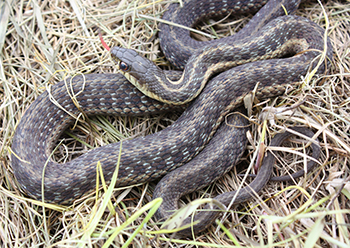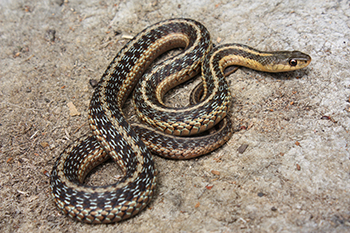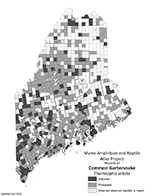Home → Fish & Wildlife → Wildlife → Species Information → Reptiles & Amphibians → Common Gartersnake
Common Gartersnake
Thamnophis sirtalis
On this page:

Photo: Trevor Persons
Distinguishing Characteristics

Photo: Trevor Persons
- Medium-sized, approximately 18 to 36 inches in length
- Brownish, olive, or grayish above with darker checkerboard pattern
- Three light yellowish stripes prominent, faint, or absent
- Plain yellowish below
- Short tail, 1/4 or less of total body length
- Dorsal scales keeled (longitudinal raised ridge along midline of each scale)
- Commonly confused with eastern ribbonsnake and common watersnake
Status and Distribution in Maine
- Common and secure
- Statewide
Habitat
- Forested uplands, brushy fields, meadows, grassland, old buildings, and rock outcrops, as well as wetter areas such as streams, bogs, and marshes
- Commonly found under rocks, logs, boards, and debris piles
Diet
- Earthworms account for 60–95% of this snake’s diet, although it also eats other invertebrates, amphibians, fish, and even small birds
Seasonal Changes
- Overwinters in upland settings, in ant mounds, rodent burrows, and root tunnels
Natural History Notes
- Most commonly encountered snake in Maine
- Gives birth to live young in July to mid-September
- Earthworms account for 60-95% of this snake’s diet, although it also eats other invertebrates, amphibians, fish, and even small birds
- May release musky discharge when handled
Share Your Sighting
There is much still to learn about the distribution and ecology of Maine’s herpetofauna, and we encourage members of the public to share their photo-documented observations as part of the Maine Amphibian & Reptile Atlas Project (MARAP).
To see if a township still needs documentation of a species, consult this distribution map (PDF). If a township lacks a photo or specimen record, we want your observation!
There are two ways to share your observations:
Submit your reptile or amphibian observation online
No service? No problem. Click here to download the survey to your device while connected, then take offline to collect observations from anywhere. Tip: The survey works best on Google Chrome and Safari.
Or upload sightings to the iNaturalist citizen science project through their website at iNaturalist.org or mobile app.
- When submitting an observation through iNaturalist add a description of the location (and other noteworthy information) to the “notes” field. This serves as a check on the locations automatically generated by smartphone cameras, which may be imprecise if cell service or GPS coverage is weak.
Thank you for doing your part to help conserve Maine’s reptiles and amphibians.
